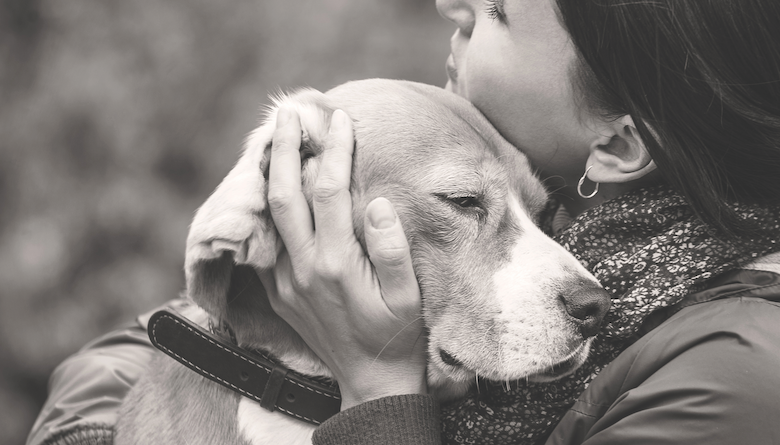When a Beloved Dog Dies
Late last year, my beloved dog Charlotte passed away after a very fast but intense battle with cancer. Charlotte started her life living on the streets before being rescued. Over the years we spent together, not only was she responsible for me making a dog-centric career change, but she taught me invaluable lessons about dogs and myself. There isn’t a day that goes by that I don’t miss her. Charlotte lived her life in my books, articles and columns, and I have continued to write about her and the lessons she taught me.
Charlotte’s ashes are in my living room along with her collar, and in my garden surrounded by flowers sits a statue that looks like her. I am also a walking memorial to my dogs — my body is covered in tattoos for each dog that has ever been part of my life. Seeing Charlotte’s portrait tattoo helps me feel like each day I’m continuing to bring her with me. Life isn’t the same without her, but memorializing her both publicly and privately helps.
Why we grieve
Mourning the death of a dog can easily feel all-consuming, and it can sometimes feel hard to know the right way to grieve. Coleen A. Ellis knows a lot about pet loss as the founder and past co-chair of the Pet Loss Professionals Alliance, past president of the International Association of Animal Hospice and Palliative Care and founder of Two Hearts Pet Loss Center.
“Wherever you are right now is exactly where you should be,” Coleen says. “The death of a beloved pet and the emotions associated with that loss will not just magically go away. We never ‘get over’ death. We get through it with our active mourning, but we won’t get over it.”

Photo: John Tsotras | Getty Images
There is no right or wrong way to grieve, but sometimes it’s hard to know where to begin to process this loss. Ann Rooney of NorthStar Veterinary Hospital provides individual and group support for the guardians of pets being treated at the clinic hospital. Her services focus on anticipatory grief as well as pet loss. She explains that grief over a dog can be so acute because a guardian is suffering four different losses, that of:
1. A protégé: We are responsible for their life, much like being a parent.
2. A life witness: They’ve been there for us in good and bad times and the major and we share with them the secrets that we wouldn’t share with another human being.
3. Routine and related relationships: Our pets sometimes generate relationships, like at agility clubs or the people met at dog parks or dog shows.
4. Unconditional love: In some cases, they are the only companion in the life of the person who cares for them.
As we grieve, it’s important to accept the loss as we honor the life of our beloved dog. Don’t expect things to go back to normal right away. As much as we miss our dogs in their passing, they continue to shape our lives. “Learn from the most amazing teacher we have, the animals, and ‘just be.’ Let those emotions happen, and be kind to yourself,” Coleen says.
Things you can do
The hardest and most important thing that any of us can do after the death of a dog is to be gentle with ourselves. Many people find solace during the grieving process by:
♥ Writing stories or poetry about their dog
♥ Painting or creating some other kind of art or memorial art piece
♥ Getting a tattoo of a dog’s portrait or paw print
♥ Creating scrapbooks, photo albums or other memory journals
♥ Planting a memorial garden
Finding permanent ways to honor the memory of a beloved dog can be extremely helpful forms of self-care and opportunities to process your dog’s passing. There are a variety of companies that can help you with this by creating everything from personalized portraits to turning ashes into a wearable stone or having them fused into a piece of glass art to creating life-like plush toys or nose print jewelry.
Funerals & memorials
Finding ways to have a ritual around your dog’s passing can help to provide closure to the death of a dog. “Do what you need to do to honor the life that was shared with a special pet,” Coleen says. “For some families this might look like a memorial service, a funeral service or some sort of ritual. Those events might be more public in nature with friends and family members involved, or it might be more private, such as a designated time in the evening to light a candle and spend some time in quiet reflection.”
For some guardians, grieving with family, friends and community feels important and helpful. If you are considering some kind of public service or memorial for your dog, Coleen offers the following suggestions for unique options for remembering:
♥ Do a bubble release
♥ Have a funeral
♥ Create a permanent memorialization piece
♥ Invite family and friends over to say their good-byes
♥ Establish a charity fund in the pet’s honor
♥ Create a memorial tribute video
♥ Share a eulogy on a social platform, your own social sites or the various places online to publicly share the life story of the pet and the human
If you and your dog had a favorite park, contact your city or the local parks department about the possibility of purchasing a plaque or memorial bench in your dog’s memory. It’s also possible to make a temporary DIY memorial for your front yard or local park. If your dog was a ball lover you might consider a favorite park or beach as a good location to leave a bucket of new dog-safe balls with a sign with your late dog’s photo explaining that other dogs should take a ball in her memory.
Just in the last month in my own neighborhood I’ve seen neighbors put out a large bowl of water with a handwritten sign tacked to the tree next to it saying that the bowl is in the memory of their beloved dog. Your dog’s memorial doesn’t have to be fancy or expensive; anything that brings you comfort is a good idea. Coleen also suggests bringing toys to donate to homeless dogs living in a shelter, or having a backyard service with a BBQ “complete with everything ‘dog’ — hot dogs, tofu-dogs, pigs in a blanket, PupCakes.”
Professional support
If at any point you feel overwhelmed by grief and need additional support, reach out to a professional pet loss and bereavement counselor or other therapist. Many humane societies or large veterinary hospitals offer support groups for people struggling with the death of a beloved dog or who are looking to connect with others who are experiencing that same loss. There are also peer-run support groups online and on social media.
There is no timetable for grieving. Coleen says, “In my work with families, I also want to bring to light the year following the pet’s death. This ‘year of firsts’ could possibly have the most elevated emotions because so many seasons, events and family rituals will happen for the first time without the animal being present. The emotions just show up and sometimes so unexpectedly: The first snowfall when the big goofy Golden Retriever is not there to roll around in the snow. The first springtime when the smell of flowers is intoxicating, but the fact that your pooch is not there to take that walk is paralyzing.” You don’t have to just get over the loss; instead continue to find ways to honor and remember your dog as you experience different seasons of grief.
Supporting friends
Grieving the death of a dog can be unique compared with other, more stay-at-home pets. Our dogs often have relationships with lots of other people outside of our immediate families — groomers, vets, trainers, and neighbors and strangers in the park who know our dog’s name but not ours.
Kaleel Sakakeeny, ordained animal chaplain and credentialed pet loss and bereavement counselor, encourages bringing friends and community into the grieving process. “I strongly believe close friends and family who know the pet or the love the person has for her pet should be part of any ritual or mourning event.
At the simplest level, if they’re asked to read a poem, tell a story, recall a moment about the pet and his relationship to his guardian, it makes the memorializing richer, deeper, more memorable because of the sharing.”
Friends, especially those who knew your dog, can be a huge support during the grieving process. Some employers have started to offer employees the opportunity to take paid bereavement time after the death of a dog, but the practice is still not particularly common, and there’s a larger cultural expectation that people will just return to life as usual despite grieving. Knowing that friends are there to listen can be supportive and meaningful to people who are struggling with that grief.
If a friend has just experienced the death of a dog, one of the most meaningful things you can do is be present and supportive regardless of if your friend wants to plan an elaborate memorial for their dog or just needs someone to talk to. Try not to make the grieving person do the outreach. Call, text, email, offer to bring over a meal, or send a condolence card. Make a donation in the memory of your friend’s late dog to a rescue group or other dog charity/organization. If you knew your friend’s dog well, offer support with planning a group or community memorial.
“If the dog and his humans belonged to an agility group, get together as the agility team members, and create a service unique to these talents and members,” Coleen says. “If the dog participated in dock-diving events, have the service there. While it seems like this is some ‘creative’ thinking as to what can be done, it’s really thinking organically as to ‘what did the pet and the family like to do together?’”
Something I’ve learned every time one of my dogs has passed is that grief comes in waves, even when I least expect it. “Love and grief will be equal, most certainly,” Coleen says. “Permission to own that grief and permission to do what their broken heart needs to do to heal by honoring the life they shared, the chapter they shared, together. Our life story is made up of so many elements of these amazing creatures and their love they gave to us, allow that love to weave into the fabric of YOUR life story without shame and with abandon!”
Although the sadness of your dog’s passing can feel overwhelming — be gentle with yourself and seek out support. Through rituals and memorials, private or public, we can keep the memory of our dogs alive for ourselves and others even if our beloved dogs are no longer physically walking beside us.
Read Next: How Do You Memorialize Your Dog?



